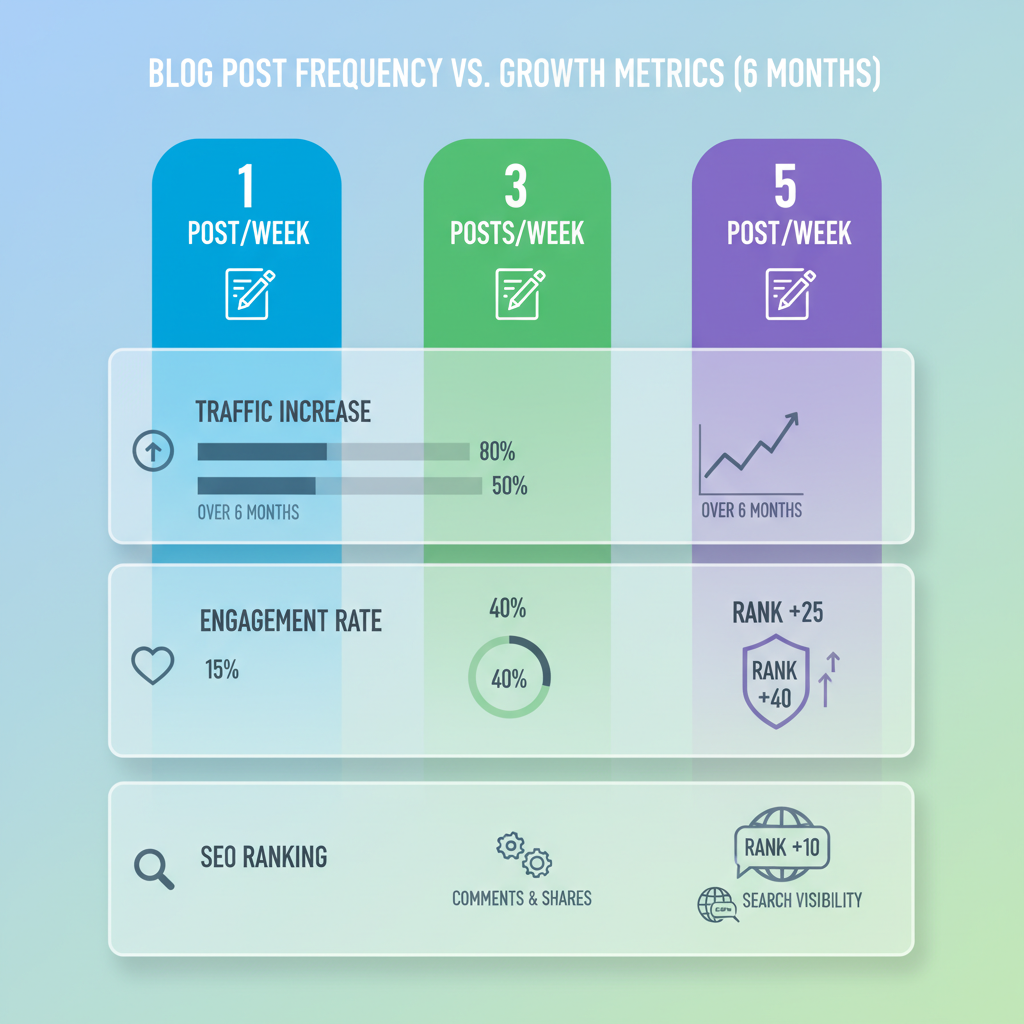How Many Blog Posts Per Week for Maximum Growth
Learn how to choose the right number of blog posts per week by balancing SEO gains, audience habits, niche norms, and sustainable content quality.

How Many Blog Posts Per Week for Maximum Growth
If you want to accelerate your blog’s growth, one of the first strategic questions you face is: How many blog posts per week should I publish? The optimal number depends on your goals, audience habits, niche norms, and available resources. This comprehensive guide explores key factors, trade-offs, and tested strategies to help you establish a posting schedule that maximizes traffic, engagement, and conversions without sacrificing quality.
---
Defining Your Blogging Goals
Before setting a publishing rhythm, clarify your primary objective:
- Traffic Growth – Prioritize SEO-friendly posts that attract organic visitors.
- Engagement – Produce content that sparks comments, shares, and builds community.
- Sales/Conversions – Craft posts that nurture leads and drive direct purchases.
Each goal demands different content types and volumes. For example, a conversion-focused business blog may rely on fewer, highly targeted pieces, while a traffic-driven site could thrive on consistent, high-volume posting.

---
Understanding Audience Consumption Habits
Your readers’ habits strongly influence optimal posting frequency. Consider:
- Daily vs. weekly visits – Do they check for fresh content regularly or occasionally?
- Preferred length – Quick updates or long-form guides?
- Platform biases – If your audience engages mainly via email or social platforms, timing and repetition are crucial.
Discover preferences from analytics, engagement statistics, and direct surveys. Aligning with these habits ensures posts are seen and valued.
---
Evaluating Your Niche’s Publishing Norms
Niche expectations set benchmarks for frequency:
- Tech news – Multiple updates daily.
- Lifestyle blogs – 1–2 posts weekly.
- Educational sites – Weekly or biweekly deep dives.
Observe competitors to learn the baseline frequency and see how often top-ranking sites publish.

---
Assessing Available Resources
Your team’s capacity dictates sustainable output. Assess:
- Writers – In-house staff or freelancers.
- Editors – Quality control is essential.
- Promoters – Ensure each post reaches intended readers.
- Budget – Outsourcing can scale production, but costs should be managed.
Be realistic: overextending can erode content quality and strain workflows.
---
Quality vs. Quantity Trade-Offs
Publishing frequently boosts visibility, but thin content damages authority. Balance:
- Quality benefits – Deeper engagement, backlinks, stronger SEO.
- Quantity benefits – Faster keyword coverage, list building.
Pro Tip: Define your minimum quality threshold first, then scale post volume within that standard.
---
Recommended Posting Frequencies
Here’s guidance for different blog stages:
| Blog Stage | Recommended Frequency | Focus Area |
|---|---|---|
| New Blog (0–6 months) | 3–5 posts/week | Build foundational content and SEO presence |
| Established Blog | 1–3 posts/week | Deepen engagement, refresh and optimize archives |
| High-Traffic Authority Site | Daily or more | Maintain topical authority and news relevance |
---
How Consistency Impacts SEO
Search engines reward regular publishing:
- Improved crawl frequency – Leads to fresher search listings.
- Expanded keyword footprint – More topics mean more search visibility.
- Trust signals – Active sites rank higher over time.
Social and content recommendation algorithms also prefer current, consistent postings, increasing reach and discovery.
---
Batching Content Creation
Batching makes it easier to stick to schedules:
- Bulk research sessions.
- Writing multiple drafts before editing.
- Scheduling content ahead of time.
This method helps maintain a steady stream without daily burnout.
---
Using Analytics to Adjust Frequency
Data-driven decisions prevent guesswork. Track:
- Pageviews per post
- Average time on page
- Bounce rate trends
- Subscriber growth
Declines in engagement after frequency changes signal a need to recalibrate.
---
Integrating Guest Posts
Guest contributions can increase content volume without straining your team:
- Tap into the guest author’s audience.
- Introduce fresh ideas and perspectives.
- Ensure alignment with your brand’s editorial standards.
---
90-Day Experiment Plan
Find the right frequency via structured testing:
- Month 1: Publish 4–5 posts weekly.
- Month 2: Shift to 2–3 posts weekly.
- Month 3: Reduce to 1–2 in-depth articles weekly.
- compare monthly metrics for traffic, engagement, and subscriber growth.

---
Recap & Actionable Steps
- Define goals – Know whether you want growth, engagement, or conversions.
- Study your audience – Post in sync with their reading habits.
- Match niche norms – Adapt publishing to competitive standards.
- Gauge your capacity – Keep output realistic and sustainable.
- Focus on quality – Maintain authority and trust.
- Test and measure – Refine with analytics-based insights.
Next Step: Launch a schedule you can consistently manage for at least 90 days, track the results, and fine-tune the cadence. The ideal number of blog posts per week is one that balances growth potential with quality and your operational reality.
By aligning publishing frequency with clear objectives, understanding your readers, and sustaining superior quality, you’ll identify the optimal schedule to achieve maximum blog growth. Start testing today to find your winning formula.



